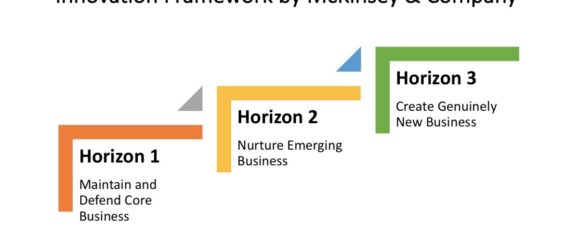What is the McKinsey & Company innovation framework, and how does it work?

Concept
McKinsey’s Three Horizons of Growth is a strategic framework focusing on business growth and innovation. It classifies causes of business growth and innovation into three groups or horizons: (1) core business, (2) adjacent business, and (3) disruptive business. Horizon one (core business) is when an organisation generates growth in sales and profits through maintaining and defending core business (e.g., improvement of existing processes for production, distribution, sales, HR, or finance). Horizon two (adjacent business) is when an organisation nurtures its business through investing in, for instance, creating a new production line, extending an existing production line, or improving features and specifications of existing products or new technology. When an organisation invests in creating a new business, it is called horizon three.

Background
The three-horizons innovation framework of McKinsey & Company was designed by Mehrdad Baghai, David White and Stephen Coley, the ex-staff of McKinsey & Company, in the book ‘ The Alchemy of Growth’ 2000. Alchemy of Growth argued the innovation growth framework encompasses a three-horizontal-factors model: the core business, adjacent business market and disruptive or new business.
How does it work?
McKinsey & Company’s innovation framework comprises three horizons (Mehrdad, White, and Coley, 2000)1:
- Horizon 1- Maintain and defend core business: this is when you invest in the core business (i.e., activities closely aligned to your current line of business) to improve revenues and profitability. Activities related to this horizon may include the day-to-day operation related to, for instance, production, technology, distribution, selling, marketing, and customer relationship. For example, when a company invests in a new technology to reduce production costs and improve lead time to the market. Typical goals for this horizon will be, for instance, improving margins, improving existing processes, increasing productivity and efficiency, and keeping cash coming in.
- Horizon 2- Nurture emerging business: it represents internal businesses on the rise: products that have customers, have perhaps achieved product-market fit, and are ready to scale. Taking what you already have and extending it into new areas of revenue-driving activity. There may be an initial cost associated with your horizon-two activities, but these investments should return fairly reliably. These horizon-two activities extend your current proven business model. Examples of horizon-two activities include launching new product lines, expanding existing products, enhancing customers’ experiences, improving marketing factors (e.g., new distribution channels), or expanding your business geographically or in new markets. These businesses have the potential to become core to the organisation.
- Horizon 3- Create genuinely new business: this involves creating a new business concept that disrupts the market. It is about creating new elements for your business that don’t exist today. Developing a new business comprises researching opportunities, inventing solutions, prototyping, experimenting, piloting new products, and investing in promising start-ups. Most of these start-ups involving this horizon, for a variety of reasons, will fail due to uncertainty and marketing reasons. These ideas may be unproven and potentially unprofitable for a significant period.
- This post is sourced from my new book- Your Guide To Reach Innovation.
Final note: the book- Your Guide To Reach Innovation, is an actionable guide to innovation from beginning to end. Enjoy reading the book, and I look forward to your reviews.
Author: Munther Al Dawood
References:
- Mehrdad, White and Coley, 2000. Innovation Framework (Three Horizons), Mckinsey & Company.
